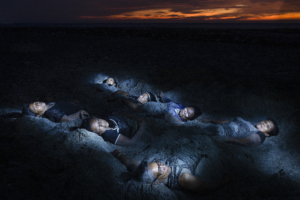Unearthing Memory
Edu León
Before the wars and exodus in Syria and Ukraine began, Colombia held the world record for refugees and displaced persons. It is the country where the most environmental leaders are killed annually worldwide. According to the NGO Global Witness, in 2022, 212 leaders were killed globally, 65 of them in Colombia. Most of these murders are related to extractive industries such as oil and mining.
This photographic work is a journey through the territories most affected by the armed conflict: Buenaventura, La Ciénaga, and El Salado, taken as a sample of a country torn by violence. It is also an exercise in memory and giving voice to the women who have been constant victims of this war that has scarred their memories and bodies. Their voices and examples offer hope for a peaceful future in the country. Through these images, the photographed individuals decide how they want their issues of exile and death to be represented. There are also portraits with projections of loved ones who were killed or left homeless during the conflict.
After four years of investigation, the Colombian Truth Commission presented its final report on the armed conflict in the country on June 28, 2022. According to the information collected in this document, at least 450,664 homicides were recorded in Colombia between 1985 and 2018 as a result of the internal armed conflict. Paramilitaries were the main perpetrators of these murders, responsible for approximately 45% of the cases, while guerrilla groups and state agents accounted for 27% and 12%, respectively. The report indicates that at least 121,768 people were disappeared during this period, about 55,770 were kidnapped, and up to 7.7 million were victims of forced displacement.
Colombia is experiencing one of the longest and most complex conflicts in the world. It is also the country where victims have formed one of the most combative civil societies, mostly composed of women. Despite being the place where, according to Amnesty International, the most people are killed for defending human rights.
There is a whole genealogy of women’s movements that have been building peace every day for decades in Colombia. Through their networked work, they have created a methodology of resistance against the institutional machinery of dispossession that fuels and sustains the war.
For the first time in Colombian history, all these experiences, discourses, and peace proposals are part of its government. The branches of the genealogy of women peacebuilders reach governmental institutions, including the vice presidency, with feminist advocate Francia Márquez. Never before has there been so much hope that, finally, there will be peace for women in Colombia.


